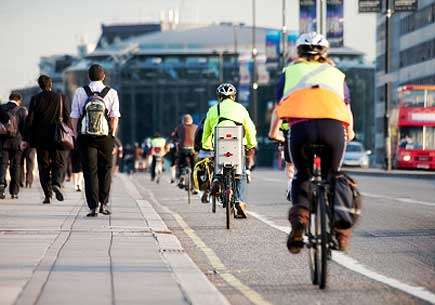(Medical Xpress)—Rapid growth of large cities throughout the world is having enormous impact on traffic safety in urban areas, say researchers at the University of Michigan Transportation Research Institute.
"Recent reports have documented and discussed the ever-increasing urbanization of nations and the resulting increase in the number of megacities—and the potential implications for traffic safety in these megacities (urban areas with 10 million or more people)," said UMTRI researcher Brandon Schoettle.
In a new study, Schoettle and colleague Michael Sivak examined road safety in two European megacities—London and Paris. An earlier study by Sivak and Shan Bao looked at New York and Los Angeles.
In all four cities, fatal crashes involving drivers and passengers in vehicles are less prevalent relative to national rates for each country. However, for pedestrians, bicyclists and motorcyclists, fatality rates are much higher in the urban areas.
In London, 53 percent of fatal crashes from 2005 to 2011 involved pedestrians, compared to 22 percent for the United Kingdom, overall. In Paris, the fatal crash rate for pedestrians in 2010-11 was 36 percent, compared to less than 13 percent for all of France.
Pedestrians were involved in half of all fatal crashes in New York City and about a third of those in Los Angeles—much higher than the 22.5 percent rate for the state of New York, 17 percent for California and 11 percent nationally from 2002 to 2009.
Likewise, riding a two-wheeler is usually more dangerous in urban areas. About 41 percent of all fatal crashes in Paris and 21 percent in London involved motorcycles, compared to rates of about 20 percent for both France and the U.K.
While bicycles were involved in slightly fewer fatal crashes in Paris relative to France on the whole, bicyclists were killed at higher rates in London, New York and Los Angeles, compared to national figures. For London, 15 percent of fatal crashes involved bicycles, compared to 5 percent for the entire U.K. The percentages for New York and Los Angeles were 6 and 3, respectively, while the U.S. rate was less than 2 percent.
For all four cities, both studies analyzed fatal crashes in terms of types of crashes and roadways, road and light conditions, driver behaviors, time of day and week, weather, age and gender.
Among the findings (relative to national rates):
- More single-vehicle crashes.
- More crashes on low-speed and one-way streets.
- More crashes and fatalities involving male drivers.
- More crashes involving drivers ages 25-45.
- Fewer crashes involving alcohol.
- Fewer crashes during rain or snow and on wet or snowy roads.
- More weekend crashes in New York and Los Angeles, but more weekday crashes in London.
- More crashes and more fatal crashes at night in New York and Los Angeles, but more crashes and more fatal crashes during morning (commuting hours) in London.
- More fatal crashes on divided highways in New York and Los Angeles, but fewer in London.
- Fewer fatal crashes caused by young drivers in Paris than in London.
- Fewer fatal crashes involving alcohol in Paris than in London.
More information: U-M Transportation Research Institute: www.umtri.umich.edu
Provided by University of Michigan


















